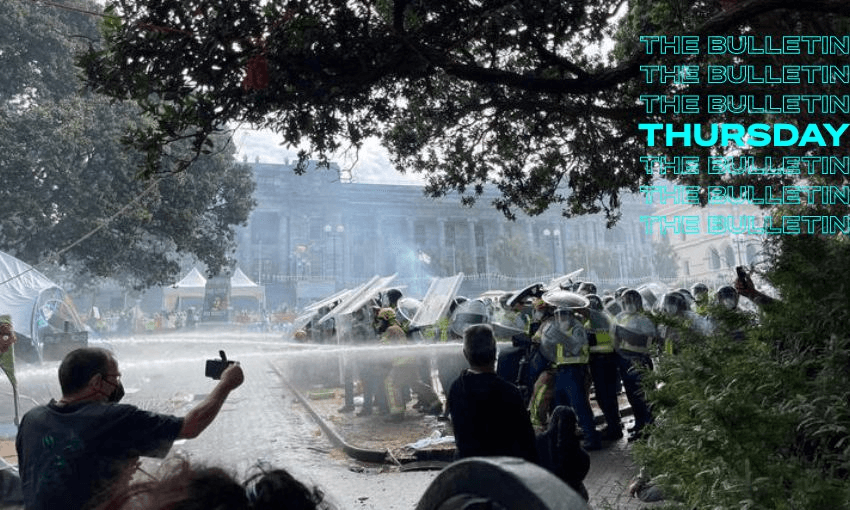A clean up is underway in Wellington, but tackling conspiracy theory is our bigger challenge, Justin Giovannetti writes in The Bulletin.
A riot that will not be soon forgotten. The occupation of parliament’s grounds ended yesterday in unprecedented scenes at the heart of New Zealand’s democracy as police and protesters engaged in a series of violent clashes that lasted for hours. What began with chest-thumping and anti-vaccine rhetoric ended in a riot, with fires set in the encampment and rioters ripping up cobblestones to hurl at police officers. The police started with shields, moved on to pepper spray and eventually bombarded rioters with firehoses and a sound cannon. Rubber bullets were deployed in the evening when the rioters began trashing neighbouring streets in the capital. I observed the protest throughout the day and contributed to The Spinoff’s live updates. The smouldering debris outside parliament now serves as a powerful symbol that misinformation and conspiracy theory are no longer limited to the digital fringe, but are a clear ailment in our national politics. In that, New Zealand now joins many of the world’s democracies.
The turning point that made police move in. As towing began of vehicles that had blocked Wellington streets for 23 days, police commissioner Andrew Coster explained yesterday morning why the decision was made to act. He said that the “makeup of the crowd” had changed, with those harbouring good intentions outnumbered by a group willing to use violence. The protest’s leaders had lost effective control. Stuff has written about the police operation that was a baptism of fire for 76 recruits who only graduated on Monday, but were needed in one of the largest police actions in the country’s history.
The fires. Coster’s words became clear on Wednesday afternoon when a fire broke out in the middle of the protest camp as it was being rapidly torn apart by police. It’s possible that the fire was accidentally started by police removing a tent. It’s what happened next that wasn’t accidental. As police fell back and the flames grew larger, rioters began throwing everything they could on the fire to make it grow and spread. It had been an ugly and violent day before that. When someone threw an LPG bottle on a fire near hundreds of people, that was a deeply dangerous and criminal act. Then more fires appeared, as rioters sensed a way to slow the police advance. They even set fire to the parliament playground. I’ve covered dozens and dozens of protests in my career. In most, my sympathies were with the protesters. Never before have I seen a protest be so reckless and offensive towards decent people. Stuff has compiled photos of the day.
What comes next for Wellington. Newshub spoke with Wellingtonians celebrating as police pushed the protesters back. There certainly is a group who support the protest, but few of them are in the capital. As RNZ reports, it’s likely the prime minister spoke for most New Zealanders when she said parliament had been “desecrated” and vowed to restore what was destroyed. There have been arrests, vehicles have been towed and some police officers are in hospital with injuries. At least one officer was carried away in a stretcher. Asked what she would tell protesters hurling heavy cobblestones at police heads, Jacinda Ardern said: “My hope is they put down their weapons long enough for the police to arrest them.” It was clearly a difficult press conference for the prime minister and honestly, for most of the reporters in the room as well. We had all just witnessed hours of fighting and were conducting a relatively normal press conference while knowing that fighting was continuing only metres away. A number of members of parliament shared their shock and distress, as the NZ Herald reports. Including National leader Christopher Luxon, who said “there’s no justification for such abhorrent behaviour.”
A postscript. As I got home yesterday evening to write this newsletter, the smell of burning plastic clung to my clothes. Quiet has largely returned to the area and as the Dominion Post reports, volunteers now want to help with the clean up. The smoke that hung over parliament will be gone this morning, the social ills won’t. Thomas Coughlan (paywalled) has looked at how we can battle misinformation. Here’s what the prime minister said about it yesterday:
“One day, it will be our job to try and understand how a group of people could succumb to such wild and dangerous mis- and disinformation. And while many of us have seen that disinformation, and dismissed it as conspiracy theory, a small portion of our society have not only believed it, they have acted on it in an extreme and violent way. That cannot stand.”
